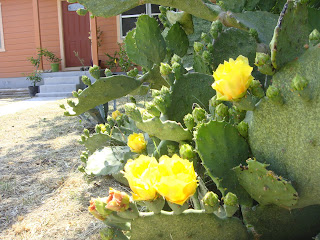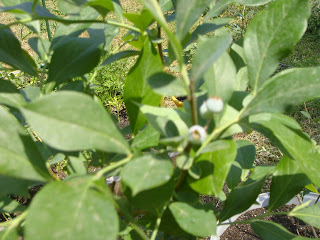I have quite a few other things I should be doing right now but I would rather do this post. This past week we had two big trees in our yard trimmed. The first tree is the giant elm which dominates our backyard (the tree guy estimated it was about 70 years old). Its obviously on the backside of its life but, since we bought the house when everything was dormant, we weren't sure of the actual condition of the tree. It turns out there is quite a bit of foliage on the branches, but there were alot of dead branches, and most of those dead branches were overhanging the house. I have also been picking up branches from that tree out
of the yard since we bought the place.

Secondly, there was a big, totally dead tree between our house and our neighbor's and, if this one came down, it would hit one of our houses. You can see the stump on the left side of the picture. This also gives me a ton more light on my garden during the morning hours:

If you click on the picture and enlarge it, you can also see the huge piles of firewood in the background, by the fence.
The plants have all been growing well, especially the tomatoes. As you can see from the pictures below, I picked up some tomato cages and staked out the Roma and Black Krim (which are growing next to each other) and the cherry tomato, which is growing by itself. The cherry tomato in particular is really big with a ton of branches and needs the extra support.


You can also see in the bottom left hand corner some new plants, where there
used to be spinach, mesclun, and buttercrunch lettuce. In fact, a few days after my previous post I went out and saw that the mesclun and spinach
had bolted and were unusable. I dug them out and added them to the
compost heap. I also ate the rest of the buttercrunch (and gave a head (shoot?) to some friends). Instead of letting the squares lay fallow, I decided to try and plant some other crops in them. I picked up a
Porter's dark cherry tomato (where the spinach was), a
Santa Fe Grand pepper (where the buttercrunch was) and a
Cayenne pepper (where the mesclun was). I turned over and heavily enriched the soil with some of my own compost and, in the case of the tomato, used some organic tomato fertilizer I have been feeding to my other tomatoes. I don't know if the plants will set fruit or develop, but it will be neat to see the results of growing two crops following closely on one another.
Since St. Patrick's day I have been
eating some of my crops, namely the cold weather greens (lettuce, mesclun, and spinach) and some green onion. But recently some new crops have been coming in, particularly the snow peas. I picked some of them earlier today (along with an onion) and am planning on making a snow pea/ szechuan pork stir fry for dinner tonight.

I picked the large and medium sized pods, but there are still many small and baby pods left, particularly towards the top of the plant.
In the front yard, the pomegranate has sprouted and is doing well. I do plan on cutting back some of the overhanging
hackberry tree branches to help it get a little more light, but that will probably have to wait until school is out.

You can see in the background, and here more closely, that the giant cactus is budding:

This is exciting because these put up a bunch of prickly pears. At the very end of the season last year, right after we moved in, I picked about a dozen of the pears and made some syrup, which is now in the freezer. This summer/fall, I hope to get more, and fresher, pears to
make better syrup.
A few days ago we went to Austin Natural Gardener and I bought a dwarf key lime tree. I have been searching all over for a key lime, but due to some stupid restrictions on shipping fruit I could not get one. This guy was kinda expensive, but I was happy to finally find one:

For the time being I'm keeping my citrus (the key lime and meyer lemon) on the front porch:

The
Mexican Plum tree is on the right, in the black nursery pot. We are going to plant it when we xeriscape the front yard in May. And speaking of xeriscaping, at Austin Natural Gardener we also bought an
Arbequina olive tree, which will be an
excellent fit in the front yard, opposite the pomegranate tree (we'll plant it at the same time as the Mexican plum).

Stay tuned for a first cut at a reassessment of this year's crops and preview of next season's plans...
 I think it looks really good and should look even better as the plants come in and fill out. The satsuma has also been pretty interesting story. You can see the progression from about a month ago:
I think it looks really good and should look even better as the plants come in and fill out. The satsuma has also been pretty interesting story. You can see the progression from about a month ago: To now:
To now: Its almost ready to pick. In addition, I got about 6 very tasty and juicy lemons off the lemon tree and some small limes from the key lime tree. These have all been outside continuously and are still doing fine, although the winter has been pretty mild. Finally, on the citrus front, a few months ago I also bought a little Kaffir Lime and its currently chilling in a pot on the back stoop.
Its almost ready to pick. In addition, I got about 6 very tasty and juicy lemons off the lemon tree and some small limes from the key lime tree. These have all been outside continuously and are still doing fine, although the winter has been pretty mild. Finally, on the citrus front, a few months ago I also bought a little Kaffir Lime and its currently chilling in a pot on the back stoop. I am going to try to do a new post in a few days on some vegetables and raised beds.
I am going to try to do a new post in a few days on some vegetables and raised beds.















































